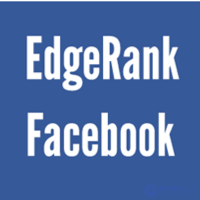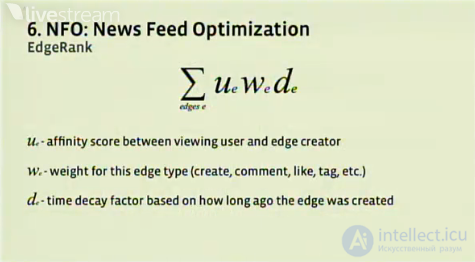
This article focuses on the EdgeRank algorithm, which is responsible for filtering news on Facebook feed.
All of you remember that in the news section you are offered to read the most popular news (“Top News”) and all recent updates (“Most Recent”). Based on your behavior, Facebook decides which news will be of interest to you and which will not, and it is this selection that is handled by the EdgeRank algorithm.
However, few people know that Facebook EdgeRank filters not only Top News, but also general news feeds. In the general tape, the algorithm in chronological order includes posts from a
specific list of friends and pages - only those from which information interesting for the recipient is expected. As you can guess, in Popular News, this qualification is even more strict.
What does this mean for you? If you constantly keep in touch with your friends, comment and like their posts - then you will stay in touch and do not miss important news.
And what if you run your special page, on which you gain new readers with great difficulty, but the return is extremely small? Are you familiar with the situation: your page has several hundred readers, but for each post you get 1-2 likes? Of course, the matter may be in your content and the way of presenting information, but EdgeRank also put its “hand” on it, when he saw that the reader showed no interest in updating your page, he simply “removed” it from the news feed.
The article will cover the EdgeRank algorithm and tips for overcoming its filters.
What is Facebook EdgeRank
The special EdgeRank algorithm was launched a year ago when it became clear that Facebook users could no longer cope with the ton of news infinitely generated by their friends in the feed. He was officially presented last April at the Facebook F8 conference conference
The algorithm automatically adjusts to each user and filters the news feed so that users receive only the information relevant to their interests. Thus, if someone places a post, it will not automatically be displayed to all of his friends. Initially, it will be tested and evaluated according to a number of criteria. As a result, this post will see only some of the friends.
The official formula of the algorithm is as follows:

In other words, EdgeRank is a complex indicator that includes three factors:
1. Affinity. Compatibility. How often friends interact on Facebook. It works in one direction: I will not be able to get into the news feed of a friend, if I constantly like his posts, he should interact with my content
2. Weight. Weight. Each type of content is evaluated differently, depending on the history of the interaction of recipients with this content and the nature of the interaction (a comment is more expensive than “like”);
3. Time. Time. How long has the post been published?
In the process of work, EdgeRank addresses user profiles, composing a portrait of their interests and relevant topics for them. The system examines the content of pages that are “hidden” by users, and also takes into account a number of other factors.
So how can you overcome Facebook EdgeRank and get into the news feed?
Tips
An unofficial percentage of fans who visit a page on Facebook only once and never return, reaches an astronomical figure - more than 90%. Many US brands spend more than $ 50,000, creating a very interactive environment on Facebook to lose fans after their first visit. In many cases, the focus is on page design, initial traffic and conversion of visitors into fans. However, little attention is paid to repeated visits and ongoing involvement through news.
Therefore, the most important advice:
motivate readers to return to your page again and again . And also -
push them to interact with your publications .
How to do it? Here are some examples.
1) Put in the statuses links to the brand page on Facebook
External clicks (to a third-party site) are relevant to EdgeRank's “earning points”, but not as much as clicks within the platform itself.
2) Ask questions
Any company status update should be an invitation for readers to chat. Questions push fans to leave a comment, because everyone likes to share their opinions. When appropriate, you can directly ask for comments. Even when a link to external content is put - on a page on Facebook or from the outside - it’s better to invite your fans to comment or click “like” on your page.
3) Invite to put the Like button
You will surely recall flash mobs dedicated to the competition “which post will get the most likes”, and yet this game brings a great return to the rhinestone in the form of returned readers. But it is suitable only for large corporations, so you should look for other creative ways to get fans to press the Like button. For example, you can use it as a voting mechanism.
4) Create polls
Facebook’s newly created survey creation option is a great opportunity to attract readers' attention and collect a rating in EdgeRank. It is as easy to vote as press “Like” - but, you see, it is much more interesting, because you express your point of view. The main thing is to come up with a good and catchy topic of the survey.
5) Download more media material.
To see the video or view the entire photo album, readers should definitely go to your page - which means you will already play to increase your rating.
6) Offer readers to share content.
By inviting fans to upload their material to the page (photos, videos, stories), you can ensure that EdgeRank will increase the rating of the company's posts. In addition, this activity of fans is “contagious”: the more fans share content, the more willing to imitate their example. But the most important thing is that such content allows potential customers to see the emotional, involved, interested reviews of real consumers of the brand. Whatever is written about the brand on its social network page is only a promise. But if his clients write about him, it means that the promises of the brand are believed and believed that he fulfills them!
7) Set up a permanent publication schedule
Approximately the same frequency of content updates, the unified nature of the content and the predictability of the topic of links help readers understand how much of their time on Facebook the brand is going to take away from them and what it is going to fill it with. And this is true for EdgeRank - the more understandable and predictable the update schedule, the better.
Brute force with post placement frequency will set EdgeRank against the brand the fastest. Therefore, it is important to establish the optimal update rate.
If posts are added on different days and at different times, it is worth narrowing down the placement time to a 1-2 hour window. Ideal posting at least once a day. However, it is more important to post actual information, even less often. Optimization is a long and painstaking process, so it’s not necessary to expect instant results.
8) Measure efficiency
The only way to get through EdgeRank's blogpost is experimenting and optimization. Each user is individual, and the algorithm formula is adapted for each individual. A high EdgeRank score of the same post for User A will be low for User B. Therefore, you need to constantly test and optimize the ideal posting methodology. But even when the methodology seems to have been created, it is necessary to continue optimization, as the fan base and content change over time.
Based on:
http://www.imediaconnection.com/content/28429.asp
http://techcrunch.com/2010/04/22/facebook-edgerank/
http://www.socialmediaexaminer.com/6-tips-to-increase-your-facebook-edgerank-and-exposure/
as well as my own experience
 This article focuses on the EdgeRank algorithm, which is responsible for filtering news on Facebook feed.
This article focuses on the EdgeRank algorithm, which is responsible for filtering news on Facebook feed.
Comments
To leave a comment
seo, smo, monetization, basics of internet marketing
Terms: seo, smo, monetization, basics of internet marketing